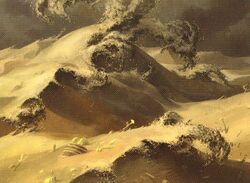Shefet
| Shefet | |
|---|---|
| The Scouring Sands | |
| Information | |
| Plane | Amonkhet |
| Colors |
|
| Type | Desert |
Shefet, called the Scouring Sands, is the chaotic dune sea that is part of the desolate wilderness around Naktamun on Amonkhet.
Description
Shefet lies immediately beyond the former protective veil of the Hekma. The desert wears away at the edges of the fertile lands surrounding Naktamun, serving as a constant reminder that only the bounty and protection of the God-Pharaoh stand between the people of the city-state and a grisly death in the sands beyond. Beyond Shefet are the parched, cracked expanses called Ramunap, the Broken Lands.[1][2]
Sandwurms are the largest predators of Shefet, swimming through the sandy dunes like serpents through the water. They are capable of amazing speed and can lift their lamprey-like heads far above the ground to snatch even flying creatures. But they can also lie in wait beneath the sands for years until the slightest tremor alerts them to the presence of prey.[2]
History
When the Gatewatch traveled to Amonkhet from Kaladesh, they found themselves amidst the dunes of Shefet, which stretched around Naktamun like a vast ocean of sand. Much like the dissenters who were exiled into the desert and left to perish by the angels, the Planeswalkers soon encountered the harsh threats and horrors of the wasteland. Unlike most outcasts, however, they possessed formidable power to protect themselves. Liliana, in particular, turned back a swarm of marauding mummies with her necromancy, though her magic proved useless when two towering shapes appeared on a nearby ridge. These figures turned out to be gods — Oketra and Hazoret — patrolling the sands to clear away threats near the city-state. Gideon was immediately awed by their presence and divine splendor. Following in the gods' wake, the Planeswalkers crossed the ridge and laid eyes on the gleaming city of Naktamun for the first time.[2]
In-game references
- Represented in:
- Associated cards:
- Referred to:
References
- ↑ James Wyatt (July 5, 2017), "Plane Shift: Amonkhet", Wizards of the Coast (pdf)
- ↑ a b c James Wyatt (July 2017) - The Art of Magic: The Gathering - Amonkhet, Viz Media.
